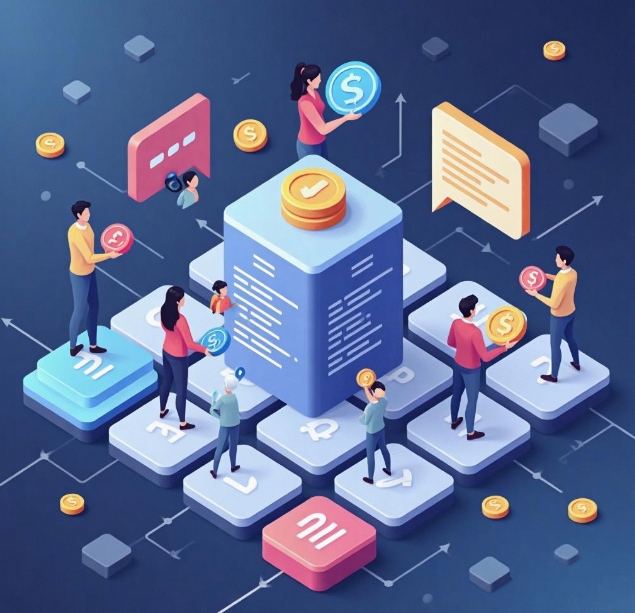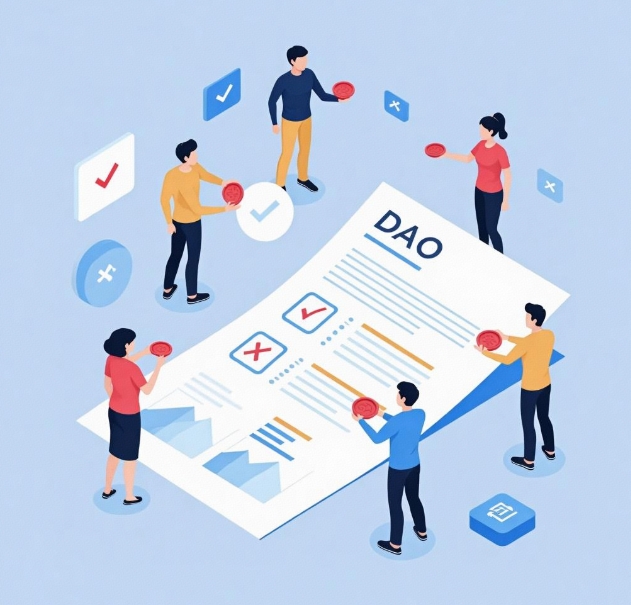DAO Development Guide: How to Build a Decentralized Autonomous Organization?
- latest articles
- 1.DApp Development & Customization: Merging Diverse Market Needs with User Experience 2.Analysis of the Core Technical System in DApp Project Development 3.How to achieve cross-chain interoperability in Web3 projects? 4.How does the tokenization of points reconstruct the e-commerce ecosystem? 5.How to Set and Track Data Metrics for a Points Mall? 6.What is DApp Development? Core Concepts and Technical Analysis 7.Inventory of commonly used Web3 development tools and usage tips 8.Development of a Distribution System Integrated with Social E-commerce 9.Six Key Steps for Businesses to Build a Points Mall System 10.What is DApp Development? A Comprehensive Guide from Concept to Implementation
- Popular Articles
- 1.Future Trends and Technology Predictions for APP Development in 2025 2.Analysis of the DeFi Ecosystem: How Developers Can Participate in Decentralized Finance Innovation 3.From Zero to One: How PI Mall Revolutionizes the Traditional E-commerce Model 4.DAPP Development | Best Practices for Professional Customization and Rapid Launch 5.Recommended by the Web3 developer community: the most noteworthy forums and resources 6.From Cloud Computing to Computing Power Leasing: Building a Flexible and Scalable Computing Resource Platform 7.How to Develop a Successful Douyin Mini Program: Technical Architecture and Best Practices 8.Shared Bike System APP: The Convenient Choice in the Era of Smart Travel 9.How to Create a Successful Dating App: From Needs Analysis to User Experience Design 10.From Design to Development: The Complete Process of Bringing an APP Idea to Life
With the continuous development of blockchain technology, Decentralized Autonomous Organizations (DAOs) have emerged as an innovative organizational structure and have gradually become a topic of great interest. DAOs not only allow members to have control over the organization but also effectively reduce the intervention of central authority, enhancing transparency and governance efficiency. This article will explore how to build a DAO, introduce the basic concepts, structure, technical implementation, and practical cases of DAOs, and provide steps and suggestions for developing a DAO to help readers understand how to build a successful decentralized autonomous organization.
I. Basic Concepts of DAOs
A DAO is a form of organization that achieves self-governance, decentralization, and automation through smart contracts. Unlike traditional centralized organizations, DAOs have no central management; instead, rules are executed via smart contracts on the blockchain, and all decisions are made collectively by community members. The operation of each DAO is automated and publicly transparent, allowing anyone to view the content of the smart contracts.
The core philosophy of a DAO lies in "decentralization," meaning there is no single center of power to control and manage all affairs. Instead, the organization's funds, resources, and decisions are managed through the consensus of community members. This characteristic makes DAOs a novel governance model, especially in the digital currency and blockchain ecosystems, with broad application prospects.
II. Structure and Components of a DAO
A DAO typically consists of the following components:
Smart Contracts
Smart contracts are the core of a DAO; all rules, decisions, and operations are executed by smart contracts. A smart contract is a self-executing contract where behaviors and rules are defined in the code, and the contract automatically executes when certain conditions are met. For DAOs, smart contracts determine governance rules, voting mechanisms, fund management, and other aspects.Governance Tokens
Governance tokens are the primary incentive mechanism in a DAO, allowing token holders to participate in decision-making. Governance tokens are typically distributed through token issuance or participation in network activities. Token holders can use them to vote, propose, or engage in other governance activities. The distribution mechanism of tokens is crucial to the governance effectiveness and fairness of the DAO.Community Members
Decisions in a DAO are typically made collectively by community members. Members vote on decisions using governance tokens, participate in proposals, modify rules, etc. Members can be anyone, usually becoming part of the community by participating in DAO activities or holding governance tokens.Proposal and Voting Mechanisms
The decision-making process in a DAO is typically conducted through proposal and voting mechanisms. Any member can submit a proposal, which may include resource allocation, rule modifications, project investments, etc. Proposals usually require a vote by community members, and those that receive majority support will be executed.
III. Technical Implementation of DAOs
The key technology for building a DAO is smart contracts. Smart contracts are programs on the blockchain that enable decentralized business logic and rules. DAOs use smart contracts to achieve self-governance, automatically executing all decisions without human intervention.
1. Choosing a Blockchain Platform
First, it is necessary to select a suitable blockchain platform for developing the DAO. Currently, Ethereum is one of the most commonly used smart contract platforms due to its robust development ecosystem and mature tool support. Ethereum provides the Solidity programming language, allowing developers to write smart contracts in Solidity. Additionally, other blockchain platforms such as Binance Smart Chain (BSC), Polkadot, and Cosmos also support smart contracts, and developers can choose different platforms based on their needs.
2. Writing Smart Contracts
When creating a DAO on a blockchain platform, developers need to write smart contracts. Smart contracts define the DAO's governance rules, fund flows, voting mechanisms, etc. When writing smart contracts, the following key elements should be considered:
Governance Rules: Smart contracts need to define the DAO's governance structure, including how members participate in voting, conditions for proposal approval, token issuance and distribution, etc.
Fund Management: DAOs typically manage certain funds, and smart contracts need to define rules for fund deposits, withdrawals, allocation, and usage.
Security: Since DAO governance is usually decentralized, any vulnerabilities in the smart contracts could lead to loss of funds or governance failure, making security crucial.
Transparency: Smart contracts must ensure that all operations are publicly transparent, allowing anyone to audit and inspect the contract content.
Developers can use programming languages like Solidity to write smart contracts, deploy them on the blockchain platform after completion, and conduct testing and optimization.
3. Deployment and Testing
After writing the smart contracts, developers need to deploy and test them on a testnet to ensure correctness and security. The testnet can simulate a real blockchain environment, helping developers identify potential vulnerabilities and issues before actual deployment.
Once testing is passed, developers can deploy the smart contracts to the mainnet, officially starting the DAO's operation. At this point, all DAO operations will be automatically executed via smart contracts, and community members can begin participating in governance, voting, and proposals.
4. Continuous Maintenance and Updates
Once a DAO's smart contracts are deployed on the blockchain network, they cannot be altered. Therefore, when designing smart contracts, special attention must be paid to flexibility and scalability. Although smart contracts are immutable, specially designed upgrade mechanisms can allow the DAO to modify or update governance rules as needed.
Additionally, the operation of a DAO requires continuous maintenance, including monitoring security, handling exceptions, and managing community activities.
IV. Governance Mechanisms of DAOs
One of the core features of a DAO is decentralized governance. DAOs govern the organization through collective decision-making, and here are some common governance mechanisms:
1. Voting Mechanisms
Voting is the fundamental method of DAO governance. Each DAO member (typically token holders) has the right to participate in decision-making through voting. Voting mechanisms can take various forms, such as:
One Person, One Vote: Each member has equal voting rights regardless of the number of tokens held.
Token-Weighted Voting: Voting rights are allocated based on the number of tokens held by members; the more tokens, the greater the voting power.
Synthetic Voting: Voting rights are allocated based on members' historical behavior or contributions to DAO activities, rewarding active participants.
2. Proposal Mechanisms
Proposals are the core process of DAO decision-making. Members can submit proposals based on their needs and organizational goals. Proposals may include fund expenditures, rule modifications, project investments, etc. Proposers typically need a certain level of support or credibility to have their proposals approved.
Proposals are decided through voting mechanisms, and only those that receive majority support are executed.
3. Transparency and Openness
All decisions, fund flows, and governance actions of a DAO are recorded on the blockchain and can be viewed by anyone at any time. This transparency is one of the key features of DAOs, ensuring that all operations align with community members' expectations and reducing the risk of corruption and abuse of power.
V. Practical Cases of DAOs
In the blockchain industry, there have been several successful DAO cases that demonstrate the practical application and potential of the DAO governance model.
1. MakerDAO
MakerDAO is one of the most well-known DAOs, aiming to create a decentralized stablecoin called Dai. MakerDAO's governance mechanism allows users holding MKR tokens to vote on key issues such as Dai's stability mechanism and risk management. The success of MakerDAO demonstrates the feasibility and potential of DAOs in the financial sector.
2. Compound
Compound is a decentralized lending protocol whose DAO governance model allows community members to participate in governance decisions through COMP tokens. Compound's community members can vote on protocol changes, fund management, and other key issues. This governance approach enables Compound to continuously optimize and improve, maintaining its leading position in the decentralized finance sector.
3. Aragon
Aragon is a decentralized governance platform that allows users to create and manage their own DAOs. Aragon provides a series of tools and templates to help users easily create decentralized autonomous organizations and implement governance, voting, and fund management functions through its platform.
VI. Steps and Suggestions for Building a DAO
Building a successful DAO is not easy. Below are some steps and suggestions to help you build a decentralized autonomous organization:
Define the DAO's Goals and Vision: First, determine the DAO's goals and vision. Is it a decentralized financial platform? Or a decentralized community management platform? Clear goals help design suitable governance structures and incentive mechanisms.
Choose a Suitable Blockchain Platform: Select an appropriate blockchain platform based on the DAO's needs. Ethereum is the most popular choice, but other platforms can also be considered.
Design Governance Mechanisms: Governance mechanisms are key to a DAO's success. Design reasonable voting, proposal, and incentive mechanisms to ensure all members have fair participation opportunities.
Write Smart Contracts and Conduct Testing: Writing smart contracts is the core of DAO development. Ensure rigorous security testing to prevent vulnerabilities and attacks.
Promote and Attract Members: The success of a DAO depends on community participation. Attract members through promotion and incentives to ensure the DAO's activity.
Continuously Optimize and Iterate: A DAO is an ongoing process that requires continuous optimization of governance rules and technical platforms to enhance user experience and community engagement.
VII. Conclusion
Decentralized Autonomous Organizations (DAOs) provide new ideas and practices for the application of blockchain technology, bringing disruptive changes to traditional organizational structures. Although building a DAO faces technical and governance challenges, the innovation and potential it brings are undoubtedly immense. With the development of blockchain technology and the deepening of its applications, DAOs will demonstrate their value in more fields and become an important component of future organizational forms.
We hope this article can provide some guidance for developers interested in building DAOs and inspire more people to participate in the exploration and practice of this innovative organizational model.
-

How to achieve cross-chain interoperability in Web3 projects?
With the continuous development of WEB3 technology, Web3 has gradually become an···
-

Inventory of commonly used Web3 development tools and usage tips
With the continuous development of blockchain technology, Web3 has become a hot ···
-

Web3 development trend prediction: analysis of future technology directions and application scenarios
With the gradual development of blockchain technology, the concept of Web3 has m···

 Blockchain
Blockchain












